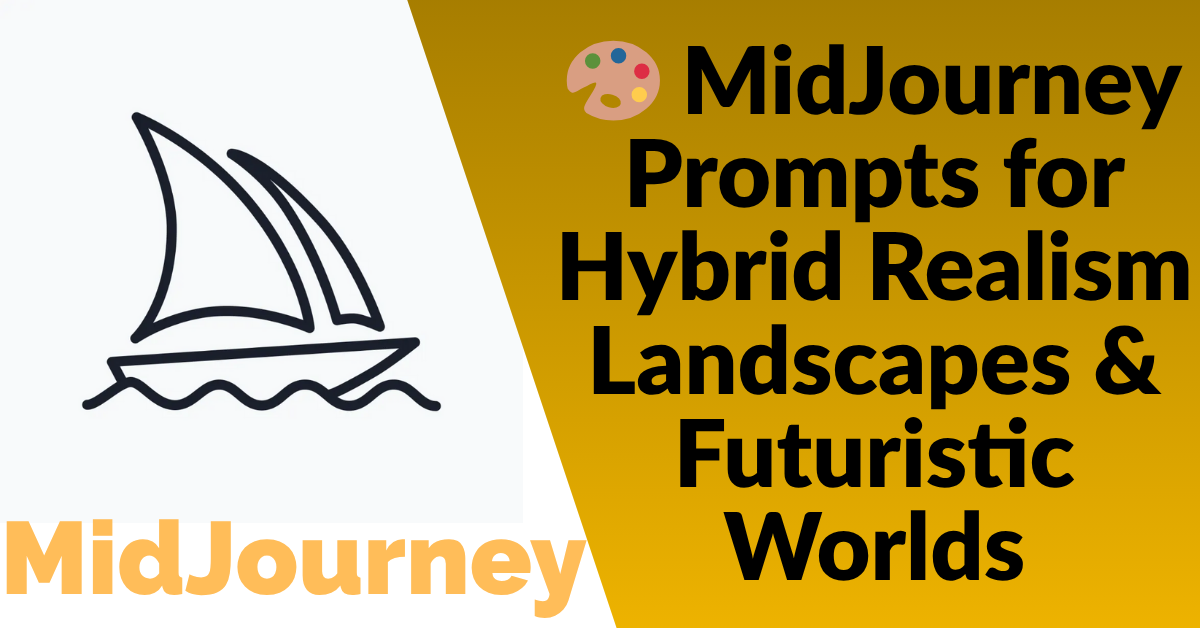
🎨 MidJourney Prompts for Hybrid Realism Landscapes & Futuristic Worlds
-
by AiPrompt
- 91
There’s a fascinating trend emerging across AI art platforms — a shift toward hyper-detailed hybrid realism, especially when it comes to landscapes that merge our natural world with speculative sci-fi architecture. MidJourney artists are pushing the boundaries of what realism can mean — fusing ultra-high-resolution nature with subtle futuristic overlays that feel both possible and poetic.
These landscapes don’t scream “sci-fi”; they whisper it. Think of a desert with monolithic structures half-buried in the sand, or alpine lakes with soft-glowing alien flora. It’s about blending what’s believable with what’s beautifully surreal. Whether you’re crafting concept art, immersive game environments, or next-gen album visuals, these prompts will unlock new possibilities for creating grounded-yet-otherworldly scenes.
🎨 MidJourney Prompts for Hybrid Realism Landscapes & Futuristic Worlds
Prompt: Ultra-realistic desert canyon with embedded alien structures, rusted metal textures, cinematic sunlight, hybrid realism –v 6 –ar 16:9 –style raw
Prompt: Snowy mountain range with ancient ruins and futuristic towers peeking through the mist, hyperreal detailing, dreamlike fusion –v 6 –ar 3:2 –style scenic
Prompt: Bioluminescent wetlands with hidden satellite domes, soft morning fog, layered realism, future meets nature –v 6 –ar 4:3 –style cinematic
Prompt: Cliffs above a glowing sea, dotted with minimalistic glass observatories, ambient colors, realistic lighting –v 6 –ar 2:3 –style raw
Prompt: Forest trail with mechanical roots and biopunk elements, moody lighting, fusion of realism and fantasy –v 6 –ar 1:1 –style cinematic
❓ FAQs
Q1: What does “hybrid realism” mean in prompts?
A: It’s a visual style that blends real-world texture and detail with subtle surreal or futuristic elements. The goal is to trick the eye just enough to make you question reality.
Q2: How do I keep things grounded while adding sci-fi?
A: Anchor your prompts in natural geography (deserts, forests, lakes), then gently introduce tech like satellites, energy domes, or alien materials.
Q3: Which aspect ratio works best for realism?
A: Use `–ar 16:9` or `3:2` for sweeping landscapes and cinematic width. If you want more vertical drama, go for `–ar 2:3`.
Q4: What lighting styles make hybrid visuals more believable?
A: Natural lighting cues like “soft morning fog,” “cinematic sunlight,” or “overcast ambient light” work best to tie elements together.
Q5: Should I use –style raw or cinematic?
A: Both work great! `–style raw` adds grit and detail, while `–style cinematic` adds mood and lighting drama. Try both for different outcomes.
🌍 Creator’s Tip:
Don’t go overboard on futuristic elements — less is more. Let the realism carry the scene, then add your sci-fi seasoning like a minimalist structure or strange flora. That contrast is where the magic happens.
Related posts:
There’s a fascinating trend emerging across AI art platforms — a shift toward hyper-detailed hybrid realism, especially when it comes to landscapes that merge our natural world with speculative sci-fi architecture. MidJourney artists are pushing the boundaries of what realism can mean — fusing ultra-high-resolution nature with subtle futuristic overlays that feel both possible and…
There’s a fascinating trend emerging across AI art platforms — a shift toward hyper-detailed hybrid realism, especially when it comes to landscapes that merge our natural world with speculative sci-fi architecture. MidJourney artists are pushing the boundaries of what realism can mean — fusing ultra-high-resolution nature with subtle futuristic overlays that feel both possible and…
